AS SEEN IN





Home » How filming a peregrine falcon nest in an industrial zone in Hull inspired new falconry paintings
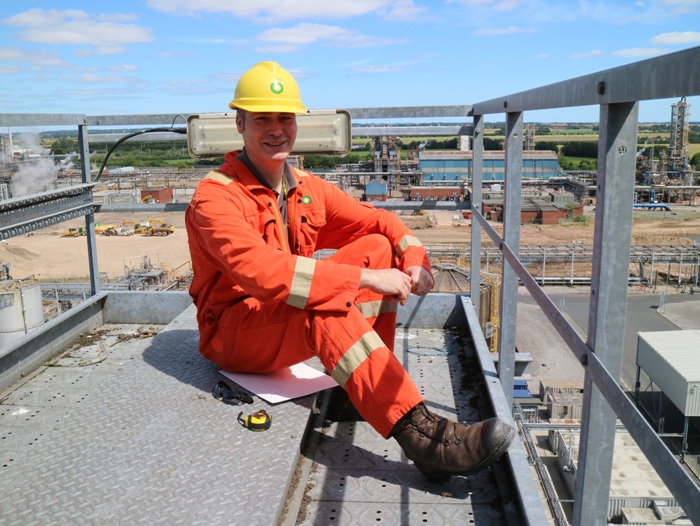
Over the years I have been to some amazing places to see some spectacular wildlife. But my adventures almost always involved travelling to wild and remote places. Occasionally I venture into urban spaces, like photographing waxwings in Huddersfield or watching roe deer in a cemetery in Glasgow. But in all my years I had never been into an industrial landscape. Then last June Jack Ashton Booth, a dedicated birder and former employee of mine, asked for a day off to ring young peregrines at Saltend Chemical Park in Hull. I was astounded to learn this 370-acre industrial site on the banks of the Humber estuary was home to a pair of breeding peregrines.
Jack explained that staff there had taken on the role of protecting the peregrines and were doing an admirable job. Among them was Mike Sibley, a bird enthusiast and former shift supervisor at BP, one of eight companies based at the site.
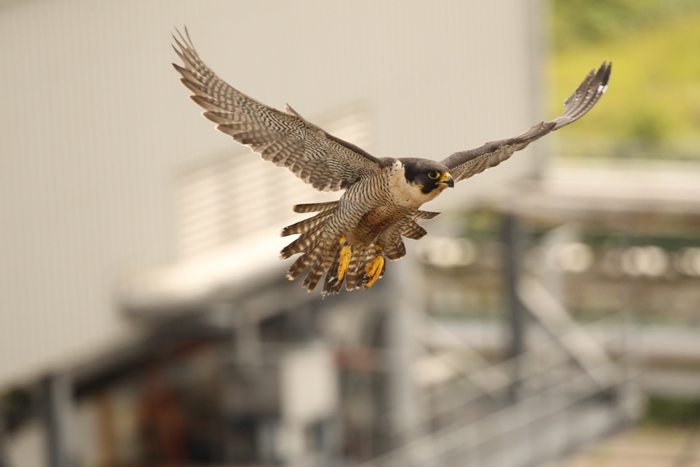
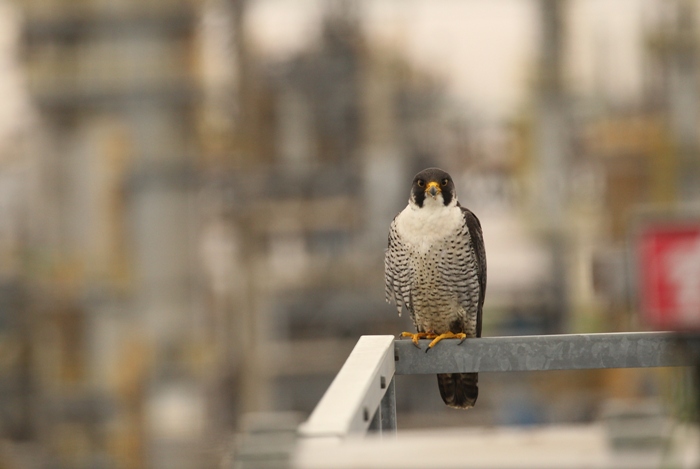
By coincidence Mike later visited an exhibition at my gallery in Thixendale. Jack introduced him to me. Their enthusiasm for the peregrines was infectious and I was delighted when Mike invited me to see the birds for myself. Just two weeks later I was inside the vast industrial site. I felt as though I had stepped onto a film set, before me stretched nothing but steel, steam and concrete. Here companies made the raw ingredients that go into everyday products like textiles, paint and pharmaceuticals. It was a sweltering hot day. In spite of the heat, Mike handed me thick fire-proof overalls, a hard hat, gloves, goggles, and steel toe capped boots. He pointed to a cooling tower high above us where I could just make out a ‘blip’. ‘That’s the female peregrine’, he told me.
I looked through my binoculars. She was perched on the site’s tallest structure, overlooking an industrial jungle of towers and pipes and beyond to the Humber. What a vantage point! The estuary was clearly an important hunting ground for this predator. Mike led me to Vivergo Fuels, a bio-fuel plant where the peregrines had their nest. Three newly-fledged peregrine chicks, two females and a male, were perched high on a grain silo.
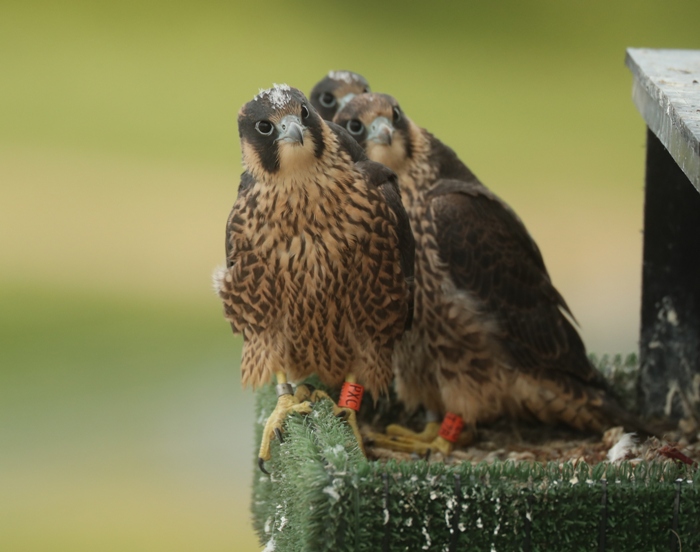

Directly beneath the peregrines a procession of lorries unloaded wheat to be turned into fuel. Steam belched from the towers. It seemed a harsh environment for falcons to bring up chicks. I followed Mike up a metal stairway that scaled a 100ft-high milling building. As we climbed higher I began to take in the sheer scale of this vast industrial site. Mike gestured to me to put my ear plugs in. We entered the building, past a wildly-gyrating milling machine. The noise must be deafening for a bird. Again I was astounded that peregrines could choose to nest here.
We went up a ladder where workers at Vivergo had built and fitted one of the best peregrine boxes I had ever seen. I was impressed at the effort they had gone to. A hole had been cut above a blast shaft for the nest box. A door from the box opened into the building where a one-way glass window enabled a secret view into the nest. The birds’ entrance to the box was outside, overlooking the industrial site. We climbed up a level and outside on to a walkway bridging the grain silos. We were now adjacent to the milling tower. Here I had a good view of the nest box, less than 30 metres away. The male peregrine flew over our heads, clearly accustomed to people and industry.
Jack and I visited again in the autumn to help clean and re-gravel the nest. This time I met more of the people involved in protecting the peregrines, among them Paul Rees, Vivergo’s process assurance manager, and falconer Paul Chambers. Paul and his father Vince, whose job it is to lag pipes for Vivergo, have been involved in helping the peregrines at Saltend since they were first discovered in 2013. At that point the falcons were on a different site inside the park. They had chosen to nest in a ‘lifting eye’, a circular cavity on the side of a steel chimney used for cranes to hoist these columns into place. Concerned that the ‘eye’ was an unsuitable place to nest, Paul and Vince had made and fitted the new nest box close to where the peregrines roosted at night. I am one of a handful of people in the UK licensed to film peregrines on the nest and I was keen for an opportunity to record this unusual site. We discussed putting up a hide so that I could study them closely.
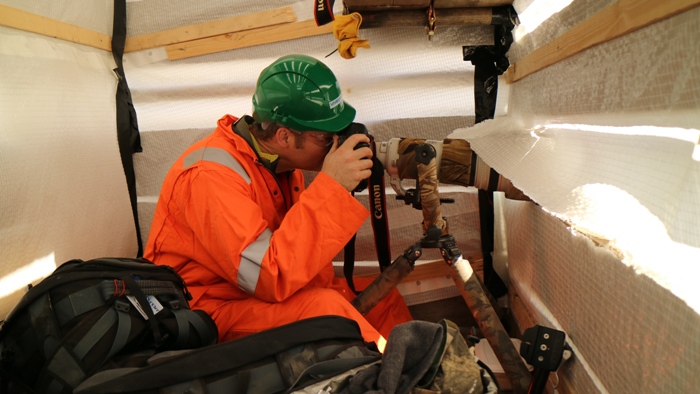

Then it was time to go. Jack and I took some feathers and remains of prey from the bottom of the nest box home to analyse the diet of these formidable hunters. Our findings were fascinating: like most peregrines they mainly ate pigeons, but their diet was also enriched by woodcock, little grebes and quail picked off the Humber, a major route for migrating birds. This was very interesting because it told me that if these peregrines were eating little grebes, which mainly fly under the cover of darkness, then they had to be hunting at night, possibly with the aid of the bright lights that illuminate this vast industrial site at night.
When I returned in April this year, a large hide had been made especially for me. Mike and I checked the nest box through the one way glass at the back. I couldn’t believe I was face to face with a female peregrine incubating her eggs. As we watched the male arrived to take his turn on the eggs. As they swapped places we spotted five dark brown speckled eggs. The chicks hatched shortly after this visit. Peregrine chicks grow fast on a high protein diet and can double their weight in just six days. At three weeks old they were 10 times their weight at hatching. At 42 days these birds would be ready to fledge.

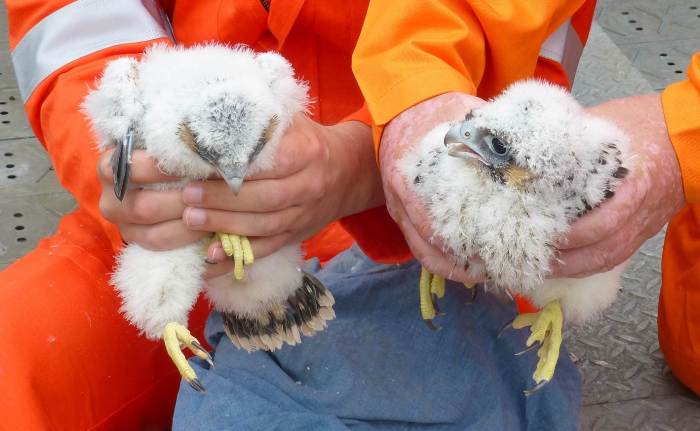
It was important to ring them first. I returned to Saltend in early June for this event. Everyone involved in the peregrine project attended since this was a chance to see the chicks close up. Paul Collins from Spurn Bird Observatory was in charge of ringing. Each chick was to have one British Trust for Ornithology ring clipped onto each leg. The first was a metal ring, ingrained with a unique identification number, the second a plastic Darvic ring, a wide orange band which can be read with binoculars. These would ensure the chicks can be traced back to Salt End.
Interestingly, the adult female wears a black Darvic ring, No: 42, which tell us she hatched from a nest on Chichester Cathedral. I marvelled at how this falcon had left the elaborate turrets of her medieval home and flown some 200 miles to settle on a chemical plant in Hull. And that she has remained here, breeding successfully, for five years.
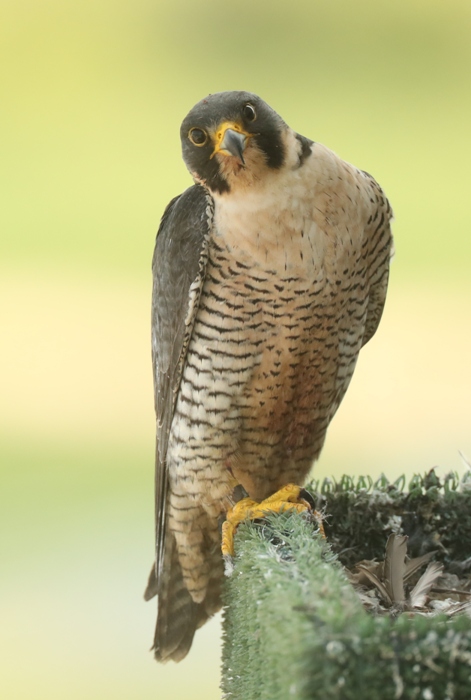

Looking out over the chemical plant, I noticed the male peregrine in full stoop. It was after a pigeon on the far side of the Vivergo site. I watched it swooping between the towers and disappear behind a plume of steam. Then the female also took off. She had spotted a wood pigeon. The pigeon plummeted to the ground with the peregrine on its tail, plucking at its feathers as it flew. With five hungry chicks to feed there was real drama in the sky.
While both parent birds were hunting, Paul caught up each chick in turn and rung them while I fitted some Gopro cameras inside the nest. These were going to record the nest for the next 12 hours. I would return to view the footage after the chicks had fledged. We worked quickly to minimise the time the chicks were away from the nest. Then we waited for the adults to return. The female flew by the box, gripping a dead pigeon in its talons. The chicks called out hungrily. As it landed one chick rushed forward and grabbed the pigeon, dragging it to the back of the box where it stood guard over it, stretching out its wings to hide it from its siblings.
I returned to Saltend in time to see a peregrine chick take its first, faltering flight. As I watched the young falcon steady itself on the shifting air currents I was overwhelmed at how this renewable energy plant’s attitude towards conservation had made a magical moment like this possible. Below is a short clip from the Gopro cameras, it shows the view from the peregrine nest and gives you an idea of what this place looked like at dusk. Just imagine them hunting against this night sky!
The story of the peregrines of Saltend is due to feature in BBC1s Inside Out Yorkshire and Lincolnshire at 7.30pm on Monday, September 17th. The piece will use my photographs and film footage, since I am one of just a handful of people in the UK licenced to photograph peregrines at their nest. Click on the image below to watch a short introduction of what you can expect to see:
The experience of watching these formidable falcons in such an unusual setting has inspired me to paint them. Watch the video as I paint the first, below, and scroll down to see the rest of the paintings of peregrine falcons that I have produced.
Click on the image above to watch the video
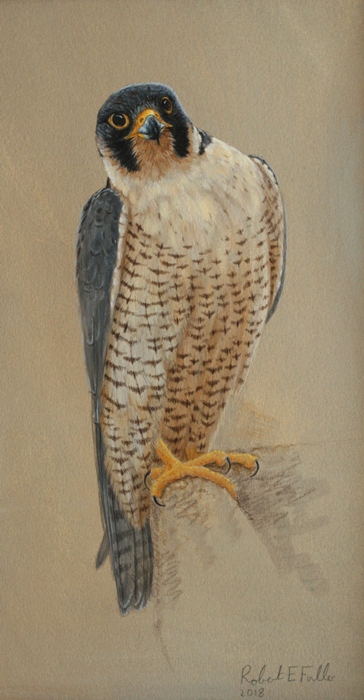
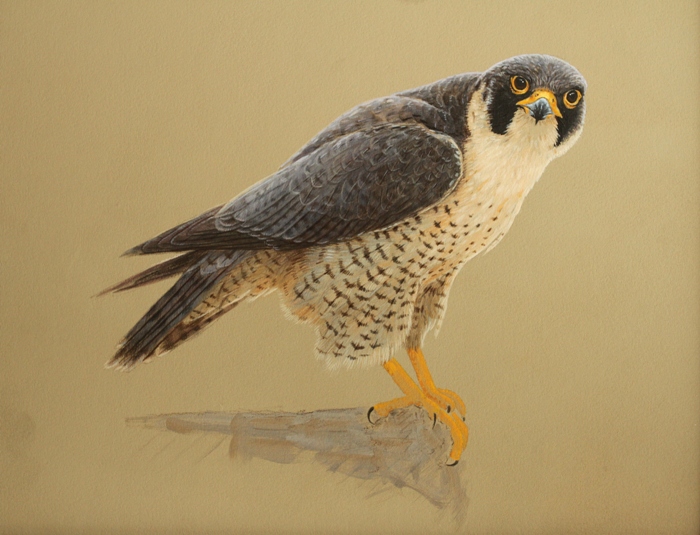
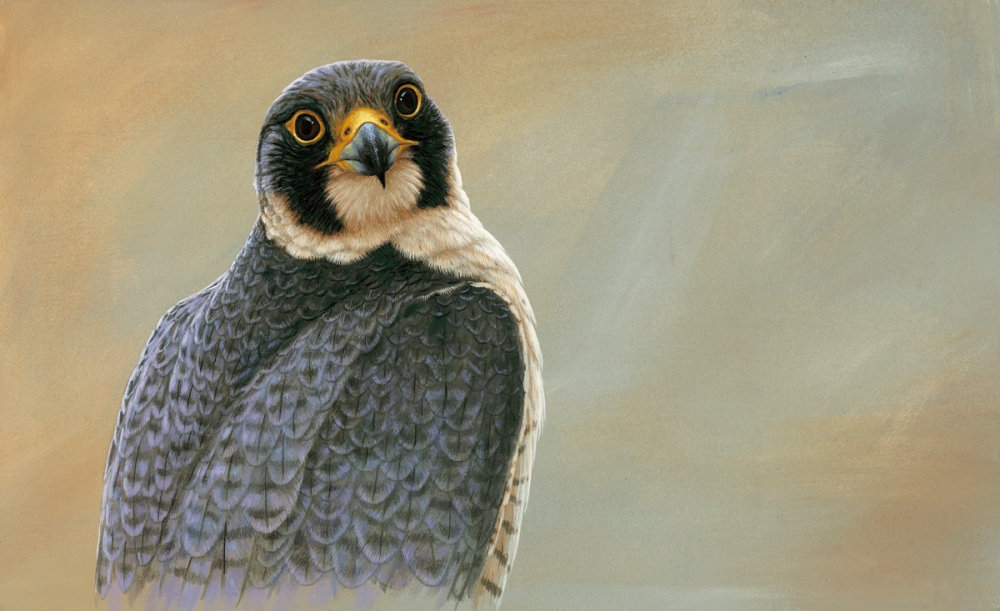

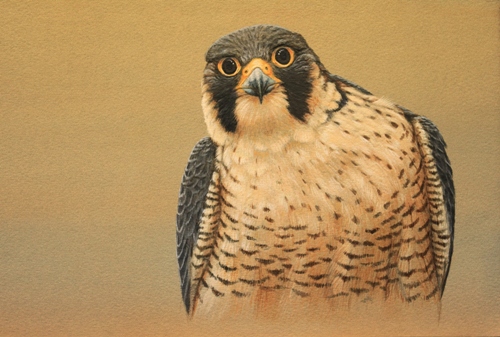
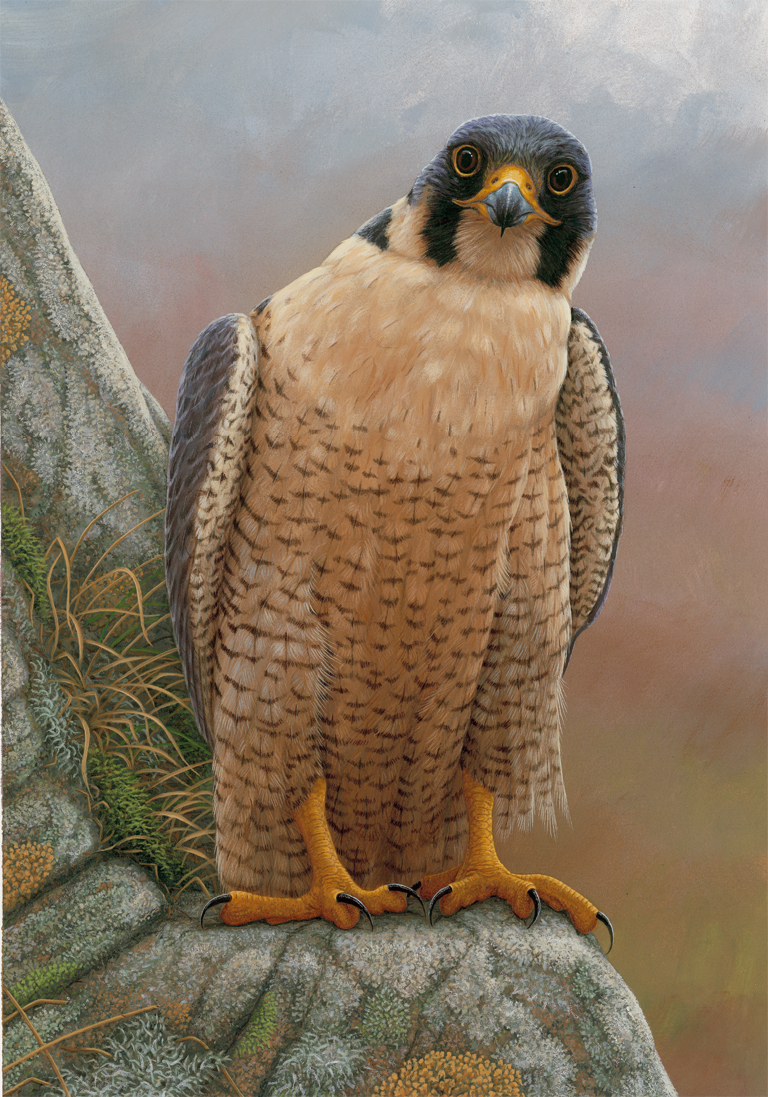 Peregrine – Powerful Predator | Original Acrylic Painting by Robert E Fuller
Peregrine – Powerful Predator | Original Acrylic Painting by Robert E Fuller
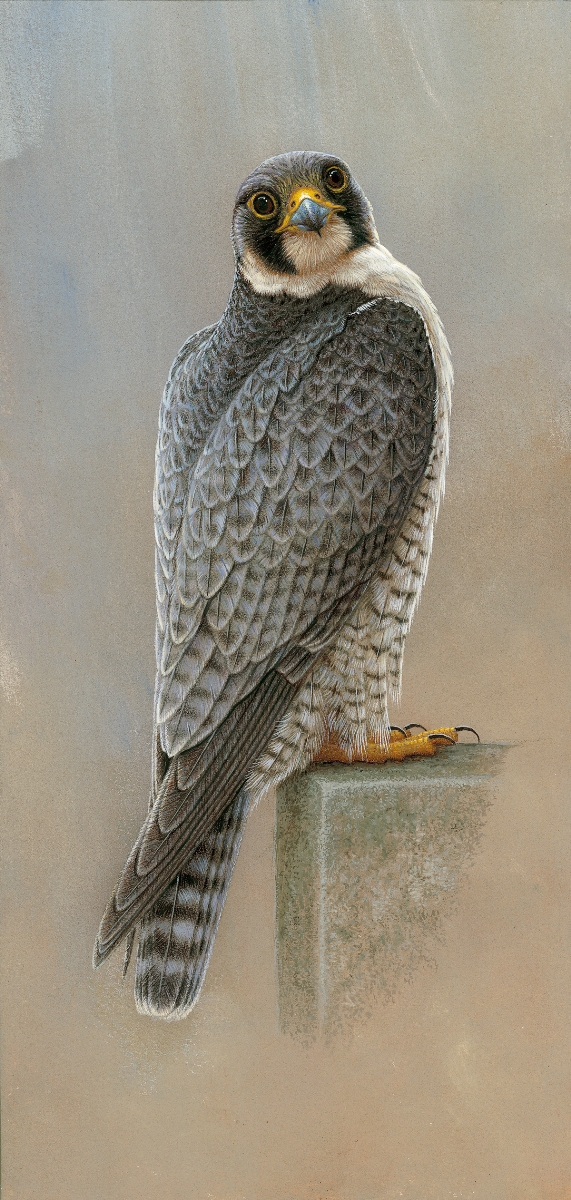 Peregrine Falcon | Original Acrylic Painting by Robert E Fuller
Peregrine Falcon | Original Acrylic Painting by Robert E Fuller
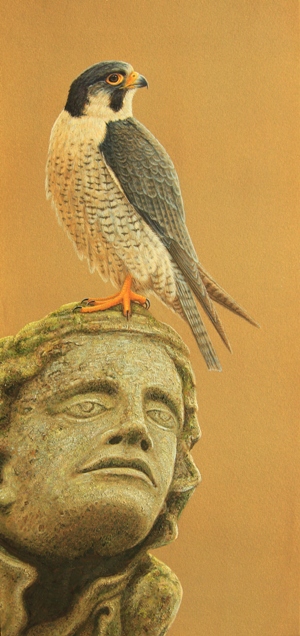

Sign up to my newsletter for updates on news, wildlife sightings, products and more directly to your inbox
AS SEEN IN





THE ROBERT FULLER GALLERY
FOTHERDALE FARM
THIXENDALE, MALTON
YO17 9LS
UNITED KINGDOM
TEL: +44 (0) 1759 368355
EMAIL: mail@robertefuller.com
4 Responses
Absolutely fascinating. I visited your studio two years ago with a Speyside Wildlife group and have been following your emails ever since! I have enjoyed every video so much as well as your descriptions of how you made them. The peregrine story tops them all. Thank you for showing me scenes I could never hope to see even as a keen birdwatch and other wildlife.enthusiast. I look forward to future emails, and videos.
Evina Montgomery